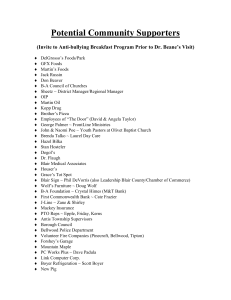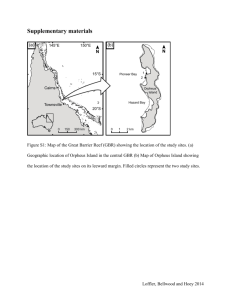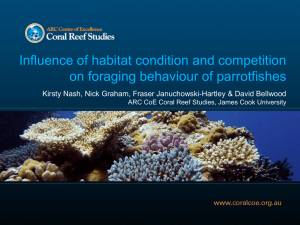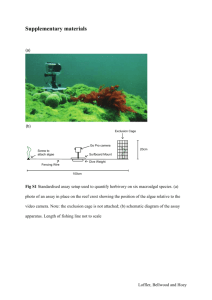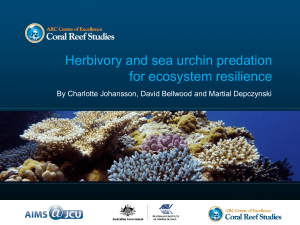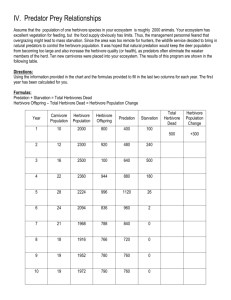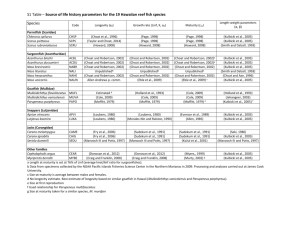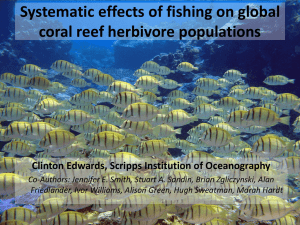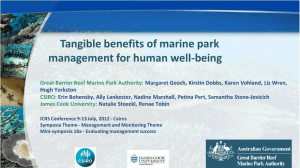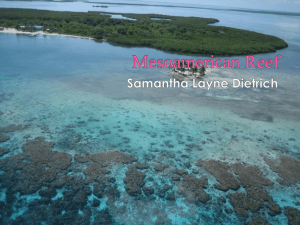1730 Fox R - 12th International Coral Reef Symposium
advertisement
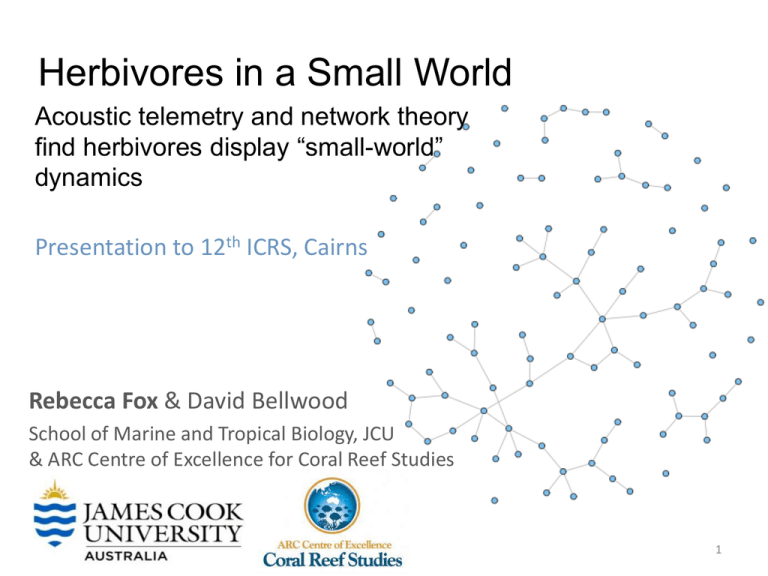
Herbivores in a Small World Acoustic telemetry and network theory find herbivores display “small-world” dynamics Presentation to 12th ICRS, Cairns Rebecca Fox & David Bellwood School of Marine and Tropical Biology, JCU & ARC Centre of Excellence for Coral Reef Studies 1 Background: Herbivore ecosystem function Scrapers (Bellwood & Choat 1990) http://australianmuseum.net.au/SwarthyParrotfish-Scarus-niger/ http://australianmuseum.net.au/Blues pine-Unicornfish-Naso-unicornis/ Excavators (Bellwood & Choat 1990) http://randomriini.blogspot.com.au/2 011/12/gili-air-day-3.html http://www.dieterkloessing.de/Malediven- www.nautilus-scuba.net/gallery Grazers Browsers (Hoey & Bellwood 2009, 2010), (Bennett & Bellwood 2010), (Cvitanovic & Bellwood 2009) (Choat at al 2002) (Fox et al 2009) www.kininmonth.com.au http://www.hawaiisfishes.com/fish_of_m onth/past_fom/fom_05_03.htm Prevention versus Bellwood et al. 2006 Reversal 2 Background: Study aims Ecosystem function = f(what you do, where you do it) Aim: investigate the long-term spatial ecology of roving herbivorous fishes 1. What level of site fidelity? 2. What degree of mobility? 3. How roving is ‘roving’? 3 4 Herbivores at Orpheus Island Chlorurus microrhinos Siganus doliatus www.nautilus-scuba.net/gallery www.panoramio.com www.kininmonth.com.au Scarus rivulatus • >90 % of roving herbivore biomass on reef crest Fox RJ & Bellwood DR (2007) Mar. Ecol. Prog. Ser. 339: 49-59. Photo: JP Krajewski Photo: JP Krajewski 5 Acoustic Array 200 m 6 Methods • 20 individuals tagged (4 x C.microrhinos, 6 x Sc.rivulatus, 10 x S.doliatus) • 23mm x 9mm transmitter inserted internally under anaesthesia (Vemco V9-1L, 60s/ 90s period, 157/ 226d battery life) • Overnight recovery then released • Data downloaded every 8 weeks 7 Results – Presence time stamps 13 Scarus rivulatus (IP) # 57472 12 11 Released PBay on 27/04/09 10 9 8 7 6 ~360m 5 4 3 2 1 39920 39970 40020 40070 40120 40170 8 months 8 Results – Residency & site attachment • High residency levels • Strong local site attachment Species n Median Size (FL) Residency (%) Site attachment (%) (cm) Mean (± SE) Mean (± SE) Siganus doliatus 10 21.3 88.3 (8.1) 100 (0) Scarus rivulatus 6 23.3 92.5 (5.4) 78.0 (13.6) Chlorurus microrhinos 4 40.6 90.1 (5.2) 98.7 (0.5) 9 Results – Detection frequencies 0-10 % PB13 11-30 % PB12 31-60 % PB11 60-100 % PB10 • Linear spatial impact (based on 90% diurnal detections) PB9 S. doliatus: 152m ± 21 C. microrhinos: 200m ± 46 Sc. rivulatus (IP): 280m ± 20 Sc. rivulatus (TP): 520m ± 158 PB8 PB7 PB6 PB5 PB4 PB3 PB2 PB1 0-10 % PB13 PB12 PB11 11-30 % 31-60 % 60-100 % • Static picture PB10 PB9 PB8 PB7 PB6 •What about the dynamics? PB5 PB4 PB3 PB2 PB1 10 www.kininmonth.com.au Background – Use of Networks in Ecology • Species-to-species interactions eg. food-webs Warren (1989) Oikos • Application to spatial ecology lagged behind Pillai et al (2010) Theor Ecol Krause et al (2003) Nature • Most existing spatial applications focus on terrestrial systems 11 Background – Network Theory Node Edge Watts & Strogatz (1998) Nature 393: 440-442 12 Herbivore dynamics 200 m Photo: JP Krajewski 13 Results - Network graphs www.panoramio.com • Directed movements between reef areas • Consistent paths www.fishbase.org • “Hub and spoke” pattern of reef utilisation www.kininmonth.com.au 14 Network metrics Regular Network • Characteristic path length (L) (Average number of edges in the shortest path between two nodes) • Degree of clustering (C) (Fraction of all potential edges between neighbouring nodes that actually exist) Random Network High path length Low path length High clustering Low clustering 15 Results – Network Analysis • Herbivore networks fall into realm of “small-world” • Vulnerable to targeted attack eg. fishing effort • Provides mechanistic explanation for vulnerability to fishing pressure (Graham et al. 2011, Ecol Lett) 16 Summary • Limited spatial impact of “roving” herbivores • High site fidelity and local site attachment • Non-random movement patterns • Fixed patterns of reef usage from “hub” • Small-worlds • Exception, male S. rivulatus 17 Conclusions • Fewer mobile links than thought • Good news:robust to random disturbances • Bad news: vulnerable to targeted attack • Maintain herbivore abundances • Network theory a useful tool for building dynamic picture of fish movements http://freshseafoodexporter.com/2011/12/07/frozenparrot-fish/ 18 Acknowledgements • Funding AATAMS (IMOS) ACRS Australian Research Council (CoECRS) Vemco (Amirix) Pty Ltd, James Cook University (GRS) • Field assistance J Bathgate, S Bennett, S Blowes, R Bonaldo, R Brooker, P Cowman, C Goatley, A Gonzalez-Cabello, C Lefevre, T Sunderland • Advice and helpful discussions A Barnett, J Bathgate, D Booth, J H Choat, J Donelson, B Ebner, C Fulton, C Simpfendorfer, T Stieglitz, P Ridd, J Theim, R Vallee, Reef-fish lab colleagues • Project logistics Staff of OIRS, Rob Gegg, Phil Osmond, J Tanner, S Wismer 19
